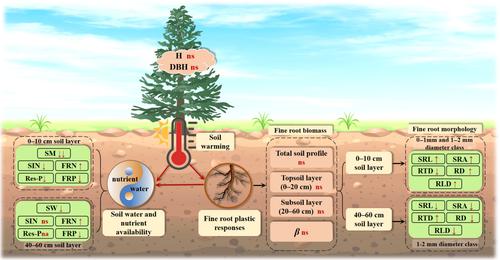Our official English website, www.x-mol.net, welcomes your feedback! (Note: you will need to create a separate account there.)
Contrasting depth‐related fine root plastic responses to soil warming in a subtropical Chinese fir plantation
Journal of Ecology ( IF 5.5 ) Pub Date : 2024-03-06 , DOI: 10.1111/1365-2745.14286 Linqiao Jia 1, 2, 3 , Qi Jiang 1, 2, 3 , Jie Sun 1, 2, 3 , David Robinson 4 , Zhijie Yang 1, 2, 3 , Xiaodong Yao 1, 2, 3 , Xiaohong Wang 1, 2, 3 , Xilin Dai 1, 2, 3 , Tingting Chen 1, 2, 3 , Dongmei Wu 1, 2, 3 , Ailian Fan 1, 2, 3 , Liuming Yang 1, 2, 3 , Guangshui Chen 1, 2, 3 , Yusheng Yang 1, 2, 3
Warming‐induced soil drought, especially in topsoil, may enlarge the spatial mismatch between nutrients and water along the soil profile, which impedes the uptake of not only water but also nutrients by trees. Therefore, coordinating the acquisition of soil water and nutrients along the soil profile is an important strategy for trees to cope with global warming. This study examined soil depth‐related changes in nutrient concentrations, biomass and morphology of fine roots in a Chinese fir plantation after 3 years of large‐scale manipulative soil warming. Soil warming (ambient +4°C) increased fine root nitrogen (N) concentrations but decreased fine root phosphorus (P) concentrations across soil depths. Warming did not affect total fine root biomass and its vertical distribution. At the 0–10 cm depth, warming increased specific root length (SRL), specific root area (SRA), fine root diameter (RD) and root length density (RLD) but reduced root tissue density (RTD). In the 40–60 cm layer, warming reduced RD, SRL and RLD while increasing RTD mainly for roots of the 1–2 mm diameter class. Synthesis . We concluded that roots of Chinese fir plantations could adapt to warming‐induced moderate water stress through contrasting depth‐related root morphological adjustments, probably to optimize the acquisition of both soil water and nutrients. The results of this study are crucial for understanding the adaptation strategies of subtropical forests under future climate conditions.
中文翻译:

亚热带杉木人工林中与深度相关的细根塑性对土壤变暖的响应对比
变暖引起的土壤干旱,特别是表土干旱,可能会增加沿土壤剖面养分和水之间的空间不匹配,这不仅阻碍了树木对水的吸收,还阻碍了养分的吸收。因此,沿着土壤剖面协调土壤水和养分的获取是树木应对全球变暖的重要策略。 本研究调查了杉木人工林经过三年大规模土壤增温后,养分浓度、生物量和细根形态与土壤深度相关的变化。 土壤变暖(环境温度+4°C)增加了细根氮(N)浓度,但降低了整个土壤深度的细根磷(P)浓度。变暖并不影响细根总生物量及其垂直分布。在0-10厘米深度,变暖增加了比根长度(SRL)、比根面积(SRA)、细根直径(RD)和根长密度(RLD),但降低了根组织密度(RTD)。在 40-60 cm 层,变暖降低了 RD、SRL 和 RLD,同时增加了 RTD,主要针对 1-2 mm 直径级别的根。 合成 。我们得出的结论是,杉木人工林的根系可以通过对比深度相关的根系形态调整来适应变暖引起的适度水分胁迫,这可能是为了优化土壤水分和养分的获取。这项研究的结果对于了解亚热带森林在未来气候条件下的适应策略至关重要。
更新日期:2024-03-06
Journal of Ecology ( IF 5.5 ) Pub Date : 2024-03-06 , DOI: 10.1111/1365-2745.14286 Linqiao Jia 1, 2, 3 , Qi Jiang 1, 2, 3 , Jie Sun 1, 2, 3 , David Robinson 4 , Zhijie Yang 1, 2, 3 , Xiaodong Yao 1, 2, 3 , Xiaohong Wang 1, 2, 3 , Xilin Dai 1, 2, 3 , Tingting Chen 1, 2, 3 , Dongmei Wu 1, 2, 3 , Ailian Fan 1, 2, 3 , Liuming Yang 1, 2, 3 , Guangshui Chen 1, 2, 3 , Yusheng Yang 1, 2, 3
Affiliation

|
中文翻译:

亚热带杉木人工林中与深度相关的细根塑性对土壤变暖的响应对比



























 京公网安备 11010802027423号
京公网安备 11010802027423号